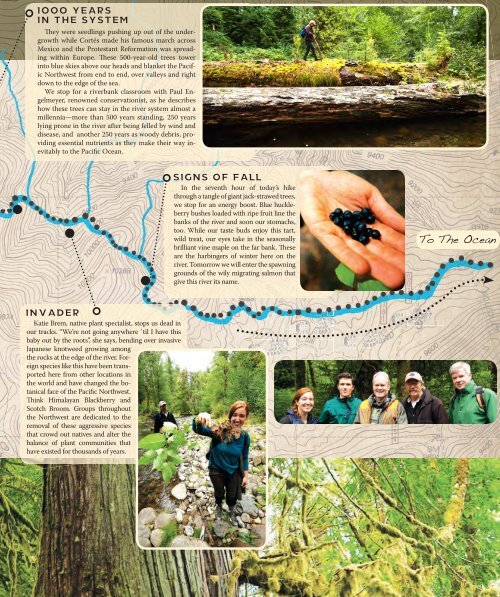You also want an ePaper? Increase the reach of your titles
YUMPU automatically turns print PDFs into web optimized ePapers that Google loves.
iooo Years<br />
in the System<br />
They were seedlings pushing up out of the undergrowth<br />
while Cortés made his famous march across<br />
Mexico and the Protestant Reformation was spreading<br />
within Europe. These 500-year-old trees tower<br />
into blue skies above our heads and blanket the Pacific<br />
Northwest from end to end, over valleys and right<br />
down to the edge of the sea.<br />
We stop for a riverbank classroom with Paul Engelmeyer,<br />
renowned conservationist, as he describes<br />
how these trees can stay in the river system almost a<br />
millennia—more than 500 years standing, 250 years<br />
lying prone in the river after being felled by wind and<br />
disease, and another 250 years as woody debris, providing<br />
essential nutrients as they make their way inevitably<br />
to the Pacific Ocean.<br />
Signs of Fall<br />
In the seventh hour of today’s hike<br />
through a tangle of giant jack-strawed trees,<br />
we stop for an energy boost. Blue huckleberry<br />
bushes loaded with ripe fruit line the<br />
banks of the river and soon our stomachs,<br />
too. While our taste buds enjoy this tart,<br />
wild treat, our eyes take in the seasonally<br />
brilliant vine maple on the far bank. These<br />
are the harbingers of winter here on the<br />
river. Tomorrow we will enter the spawning<br />
grounds of the wily migrating salmon that<br />
give this river its name.<br />
To The Ocean<br />
Invader<br />
Katie Brem, native plant specialist, stops us dead in<br />
our tracks. “We’re not going anywhere `til I have this<br />
baby out by the roots”, she says, bending over invasive<br />
Japanese knotweed growing among<br />
the rocks at the edge of the river. Foreign<br />
species like this have been transported<br />
here from other locations in<br />
the world and have changed the botanical<br />
face of the Pacific Northwest.<br />
Think Himalayan Blackberry and<br />
Scotch Broom. Groups throughout<br />
the Northwest are dedicated to the<br />
removal of these aggressive species<br />
that crowd out natives and alter the<br />
balance of plant communities that<br />
have existed for thousands of years.

















